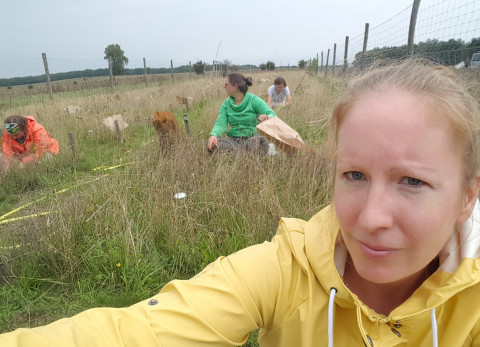Looking for student(s) to work with me!

Looking for student(s) to work with me!
Happy new year to everyone!
Research is always team work and thus, I am looking for more members to join our team! Hereby a short decription of the project and some ideas for student projects. All ideas are welcome, please contact me if you are interested!
In this project, we will set-up controlled mesocosm analysis outside the NIOO-KNAW and combine them with stable isotope techniques and next-generation sequencing (NGS). The key idea of the mesocosm experiment is to decrease the inherent variability in soils to gain understanding on mechanisms and be able to calculate carbon budgets of the soils in a standardized way. The changing variables will be fungal abundance and traits as well as intensity of agricultural management. Within this framework, students are encouraged to work on either the main project together with me or have their own side-project on topics of their interest. Generally students can opt to help in the monitoring and setting up the experiment and analysing the samples and data on for example the fungal communities, their abundances, other creatures in the soil or for example crop yield. This requires some previous knowledge on molecular work (fungal diversity) and/or biochemical analysis (ergosterol, PLFAs). Also other ideas like monitoring soil communities of for example insects in time are possible. I have furthermore some ideas for more specific projects such as:
Student project A: Fungal traits for carbon sequestration (possible starting date earliest spring 2020-)
In the main experiment three different fungal inocula with different amount and types of fungi will be used. The aim of this subproject is to characterize by cultivation based methods as many as possible of the fungi in these soils. These fungi will be first cultured using dilution method and few different media to cover both yeasts and fast- and slow-growing fungi. Then these fungi will be identified using sequencing and selected traits will be measured. Initially these traits include growth rate on various substances, hyphal extension, pathogen suppression etc etc. Later, they will be tested for their respiration in soils both alone and in combinations with other fungi as well as with fungal feeding organisms (see project B)
Student project B: Fungal traits as part of the soil foodweb (possible starting date earliest summer 2020-)
This project continues with the fungal cultures isolated in the previous project and aims to describe how does the ability of fungi to sequester carbon change in the presence of pathogens, parasites, and fungal feeding organisms. This work will be done in small scale microcosms but will also have direct link to the main experiment in terms of using fungal feeders present in those soils.
Student project C: Fungal abundance affecting insect diversity (summer 2020 or summer 2021)
In this project the effects of different fungal communities (and their traits) on insects visiting plants in the outside mesocosms will be measured. The fungal diversity and abundance will be simultaneously measured as well as plant yield. Also, the fungal communities in the insects can be measured (using sequencing). It is possible also to test the effects of some insecticides/fungicides as treatments or in a separate experiment.
Student project D: How to restore degraded soils (starting earliest summer 2020)
In this project a fungal inoculum with few identified fungal species will be tested on the most degraded soil with the idea that it can improve the carbon sequestration potential in these soils. There is also possibility to use fungi selected in the project A.
For more information and expression of interest, please contact me, Emilia (e.hannula@nioo.knaw.nl)

